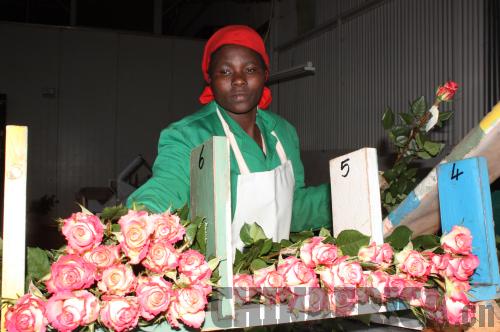|
 |
|
IN BLOOM: Mercy Kagendo grades roses before packaging at Kisima flower farm in Timau, Kenya |
Naivasha, the sleepy town deep inside Kenya's Rift Valley, may not be known all over the world, or even in some parts of East Africa, but it is the hub of a flower industry that earns the country billions of Kenyan shillings in crucial foreign currency.
The massive flower farms lie adjacent to affluent country lodges in a tranquil environment under wild acacia trees. The area makes the town a perfect setting for city getaways, and a perfect destination for honeymooning couples.
However, the residents of the area owe their livelihoods to the horticulture business. Although flower farm laborers' wages are low, even by Kenyan standards, they do put food on the table and keep people off the streets.
These farms export their flowers to Europe, and following the recession in that market, they are now exploring the far-East. Some have even landed contracts in Japan and Russia.
A recovering market
The bad economic news from Europe, following the global economic crisis in 2009, saw the flower sales in Kenya dip from a high of $485 million (Ksh 39.7 billion) to $447 million (Ksh 36 billion). This fell further in 2010 to $432 million (Ksh 35.5 billion), according to the Kenya Flower Council.
The council says that according to a horticultural validated report in 2011, the main cut flowers grown in Kenya are roses (87.7 percent), carnations (7.4 percent) and alstromeria (1.8 percent). Other flowers cultivated include gypsophilla, lilies, eryngiums, arabicum, hypericum, statice, and a range of summer flowers amongst many others.
In 2011, flower sales jumped to $542 million (Ksh44 billion), just as Europe recovered and the pressures of the economic crisis eased.
The council said that on the global front, a growth of 5 percent is anticipated in 2012. The industry is expected to continue to grow, but at a slower rate than previous years.
However, the danger posed by the economic turmoil in Europe, and American debt woes, has flower exporters on tenterhooks and considering other markets.
The Kenya Flower Council said, however, that it had no current record of flower sales to China. The council's communications officer, Winnie Muya, told ChinAfrica, "We don't know if anyone has been to China to sell flowers. I think they grow flowers there, but we'll know when the returns for this year come in."
The council meets annually to calculate exports and compute the income that the industry gets from the sale of flowers both in and outside Kenya, although the bulk of their income is from the export market.
Thanks to a sound and technically efficient infrastructure, a climate conducive to flower growing, and an active workforce, the industry continues to attract investors.
The council says Kenya's flower farmers are using technology that includes computerized drip irrigation and greenhouse ventilation systems, as well as artificial lighting to increase day length to boost an industry that sees an estimated 500,000 people (including over 90,000 flower farm employees) depend on the flowers for a livelihood.
|